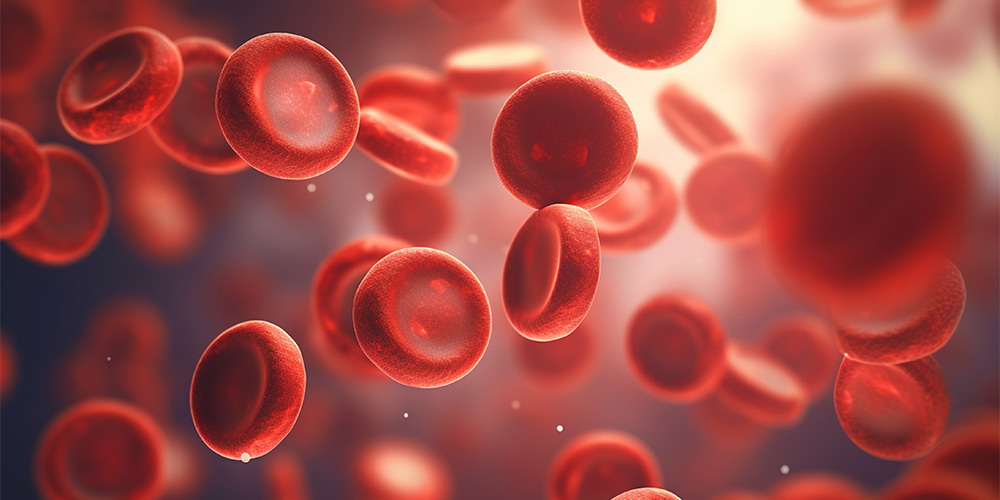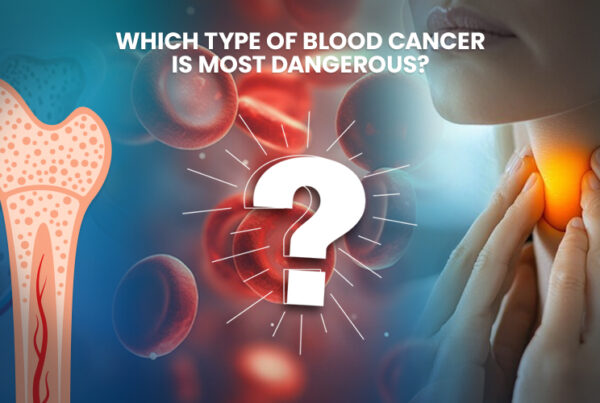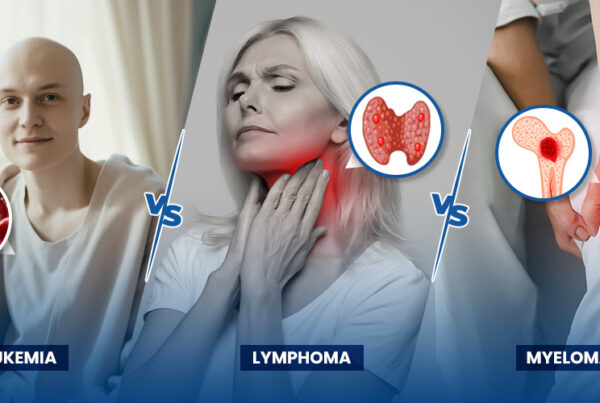
What is Blood Cancer?
Blood cancer, also called hematologic cancer, starts in the blood-forming tissues like bone marrow and the lymphatic system. It messes with how blood cells are made and how they function. Since blood plays a huge role in oxygen transport, immunity, and clotting, any cancer affecting it can seriously impact your health and quality of life.
Read along to understand the different types of blood cancers, their origins, and how they differ in symptoms, treatment, and progression.
Understanding Blood and Blood Cells
Your blood is made up of three key types of cells, each playing a vital role in maintaining your health and supporting life. Together, these cells work harmoniously to keep you functioning at your best.
Types of Blood Cells
Red blood cells (RBCs): These cells are like little oxygen carriers, traveling through your bloodstream to deliver oxygen and nutrients to organs and tissues, and help remove waste products.
White blood cells (WBCs): Your body’s first line of defense, these cells work to protect you from infections and foreign invaders by identifying and fighting off pathogens.
Platelets: Platelets are your body’s natural bandages. They help with blood clotting and are essential for wound healing.
Blood cells are created in the bone marrow and work together to transport oxygen, fight infections, and help heal injuries. However, when these cells start to grow uncontrollably or abnormally, it can result in serious blood disorders or hematologic cancers.
Blood cancers can be broadly divided into three main categories:
- Leukemia
- Lymphoma
- Myeloma
Differences Between Leukemia, Lymphoma and Myeloma are important to understand, as each type of blood cancer affects different cells and functions within the blood and immune system.
Leukemia
Leukemia is a type of cancer that affects the blood and bone marrow, often involving an abnormal production of white blood cells. However, these cells aren’t functioning properly. Instead of protecting the body from infections, they are ineffective and multiply uncontrollably, crowding out healthy blood cells.
Leukemia can be classified in two primary ways:
1. By disease progression:
- Acute (fast-growing): The cancer progresses rapidly and requires immediate treatment.
- Chronic (slow-growing): The disease develops more gradually, and symptoms might appear over time.
2. By the cell type affected:
- Lymphocytic: This type of leukemia affects lymphoid cells, which are crucial for immune defense.
- Myeloid: This type affects myeloid cells, which produce red blood cells, platelets, and certain white blood cells.
When combining these criteria, leukemia is categorized into four main types, each with distinct characteristics
Read More: How Is Leukemia Diagnosed?
Main Types of Leukemia
| Type | Progression | Cell Type Affected | Common Age Group | Description |
|---|---|---|---|---|
| Acute Lymphocytic Leukemia (ALL) | Acute | Lymphoid cells | Most common in children, also adults | Rapidly growing cancer starts in immature lymphocytes. It spreads quickly and requires prompt treatment. |
| Acute Myeloid Leukemia (AML) | Acute | Myeloid cells | Most common acute leukemia in adults, also seen in children | Fast-growing cancer originates from myeloid cells, which form red cells, white cells, and platelets. Requires urgent treatment. |
| Chronic Lymphocytic Leukemia (CLL) | Chronic | Lymphoid cells | Most common chronic leukemia in adults (especially older adults) | Slow-growing cancer of mature lymphocytes. May not cause symptoms for years and often discovered incidentally. |
| Chronic Myeloid Leukemia (CML) | Chronic | Myeloid cells | Mainly affects adults | Slow-growing cancer of myeloid cells, often associated with a specific genetic abnormality (Philadelphia chromosome). May remain stable for years before accelerating. |
Difference Between Chronic and Acute Leukemia
Acute leukemia progresses rapidly and requires immediate treatment. Chronic leukemia, on the other hand, develops slowly and might not show symptoms at first. Treatment depends on the type and stage.
Symptoms Specific to Leukemia:
- Persistent fatigue and weakness
- Frequent or severe infections
- Unexplained bruising or bleeding
- Tiny red or purple spots (petechiae) on the skin
- Bone pain or tenderness
- Swollen lymph nodes (usually painless)
- Enlarged spleen or liver
- Night sweats
- Pale skin
- Shortness of breath
These symptoms don’t guarantee leukemia but if someone experiences several of them for a prolonged time, especially alongside fatigue and weight loss, it’s important to get checked immediately.
Survival Rates
ALL: ~70% 5-year survival rate in children
AML: ~29% 5-year survival rate in adults
CLL: ~87% 5-year survival rate
CML: ~70%+ with targeted therapy
Lymphoma
Lymphoma is a cancer of the lymphatic system, which is part of your immune system responsible for fighting infections and diseases. It starts when your body starts producing an abnormal number of lymphocytes (a type of white blood cell).
This often results in tumors in the lymph nodes and other lymphatic tissues. Over time, these abnormal cells can collect in lymph nodes or other parts of the lymphatic system, forming tumors and weakening your immune response.
Types of Lymphoma
Lymphoma is broadly divided into two main types, based on the kind of cells involved and how the disease behaves. Understanding the differences in Hodgkin vs Non-Hodgkin Lymphoma is key to diagnosis and treatment.
1. Hodgkin Lymphoma (HL)
- Characterized by the presence of a specific abnormal cell called the Reed-Sternberg cell.
- Often starts in the upper body (neck, chest, or armpits).
- Tends to spread in an orderly way from one lymph node group to another.
- Highly treatable, especially in younger patients.
2. Non-Hodgkin Lymphoma (NHL)
- A larger, more diverse group of lymphomas that do not contain Reed-Sternberg cells.
- Can start in B cells or T cells.
- T-cell lymphoma tends to be more aggressive and less responsive to treatment compared to B-cell types.
- May arise in lymph nodes or other organs.
- Treatment success varies based on the subtype.
Common Subtypes of Non-Hodgkin Lymphoma (NHL)
| Subtype | Cell Origin | Growth Rate | Common Age Group | Key Features |
|---|---|---|---|---|
| Diffuse Large B-Cell Lymphoma (DLBCL) | B-cell | Fast-growing (aggressive) | Middle-aged to older adults | Most common NHL; often curable with prompt treatment |
| Follicular Lymphoma | B-cell | Slow-growing (indolent) | Older adults (typically 60+) | May not need treatment right away; tends to recur |
| Mantle Cell Lymphoma | B-cell | Moderately aggressive | Older adults (usually 60+) | Rare; usually diagnosed at an advanced stage |
| Burkitt Lymphoma | B-cell | Very fast-growing | Children and young adults | Requires urgent treatment; sometimes linked to EBV |
| Peripheral T-Cell Lymphoma | T-cell | Fast-growing (aggressive) | Adults (40+) | Less common; diverse group with variable outcomes |
| Marginal Zone Lymphomas (e.g. MALT) | B-cell | Slow-growing (indolent) | Adults (50+) | Often linked to chronic infection or autoimmune conditions |
Hodgkin vs Non-Hodgkin Lymphoma
Hodgkin Lymphoma is more predictable and often responds well to treatment. Non-Hodgkin Lymphomas vary a lot in how aggressive they are. Hodgkin has a higher survival rate.
Symptoms Specific to Lymphoma
- Swollen, painless lymph nodes in neck, armpit, or groin
- Persistent fatigue
- Unexplained weight loss
- Fever and chills without infection
- Night sweats (often soaking)
- Itchy skin
- Cough or shortness of breath (due to enlarged lymph nodes pressing on airways)
- Chest pain or discomfort
- Abdominal swelling or pain
Hodgkin Lymphoma may have additional symptoms like:
- Alcohol-induced lymph node pain
- More localized lymph node swelling
Survival Rates
Hodgkin Lymphoma: ~88% 5-year survival rate
Non-Hodgkin Lymphoma: Varies (e.g., ~64% overall)
Myeloma
What is Multiple Myeloma?
Multiple Myeloma is a cancer of plasma cells, a type of white blood cell that produces antibodies. When these cells grow uncontrollably, they build up in the bone marrow and crowd out healthy blood cells.
But there are several other subtypes of Myeloma as well.
Types of Myelomas:
| Subtype | Description | Key Features |
|---|---|---|
| Multiple Myeloma | The most common type. Cancerous plasma cells build up in the bone marrow and crowd out healthy cells. | Bone pain, anemia, kidney damage, CRAB symptoms |
| Smoldering Myeloma (Asymptomatic) | A slower-growing, early form of multiple myeloma that doesn’t yet cause symptoms or organ damage. | No symptoms, discovered during routine blood tests |
| Solitary Plasmacytoma | A single tumor of myeloma cells, either in the bone or soft tissues. | Localized bone pain, risk of progressing to multiple myeloma |
| Light Chain Myeloma | A form where abnormal plasma cells produce only light chains (not full antibodies), leading to kidney problems. | High risk of kidney damage, protein in urine (Bence-Jones) |
| Non-Secretory Myeloma | Rare type where abnormal plasma cells don’t release detectable antibodies in the blood or urine. | Harder to detect with standard tests, symptoms similar to others |
| IgA, IgG, IgM, IgD, IgE Myeloma | Classified by the type of immunoglobulin (antibody) the cancer cells produce. IgG is most common, IgE is very rare. | Varies by type; may affect prognosis and treatment plan |
Also Read: Is Multiple Myeloma Hereditary?
Common Signs (Often summarized as CRAB):
- Calcium elevation: Thirst, nausea, confusion, constipation
- Renal (kidney) dysfunction: Decreased urine output, swelling, fatigue
- Anemia: Fatigue, dizziness, pale skin
- Bone damage: Bone pain (back or ribs), frequent fractures
Other signs include:
- Frequent infections
- Weakness or numbness (if spinal cord is affected)
- Weight loss
- Unexplained bruising or bleeding
Survival Rate
The average 5-year survival rate is about 57%. New therapies have improved outcomes in recent years.
Other Rare Types of Blood Cancer:
Hairy Cell Leukemia: A rare, slow-growing type of leukemia that affects B lymphocytes.
Mast Cell Leukemia (MCL): A rare and aggressive leukemia caused by the excessive growth of malignant mast cells, often leading to severe allergy-like symptoms and organ damage.
Large Granular Leukemia (LGL): A slow-growing cancer of large granular lymphocytes, commonly associated with autoimmune disorders and low blood cell counts.
Chronic Myelomonocytic Leukemia (CMML): A rare leukemia that starts in myeloid cells and can progress to acute myeloid leukemia (AML); mostly affects older adults.
Myelodysplastic Syndromes (MDS): A group of disorders where the bone marrow fails to produce enough healthy blood cells. Often considered early forms of leukemia.
Myeloproliferative Neoplasms (MPN): A set of conditions where the bone marrow makes too many blood cells, disrupting normal blood production.
- Polycythaemia Vera: Overproduction of red blood cells.
- Essential Thrombocythaemia: Excessive production of platelets.
- Myelofibrosis: Formation of scar tissue in the bone marrow, leading to disrupted blood cell production.
What Type of Cancer Causes Low Hemoglobin?
What Type of Cancer Causes Low Hemoglobin? Blood cancers like leukemia, MDS, and myelofibrosis can cause low hemoglobin levels due to disrupted red blood cell production. This often leads to symptoms like fatigue and weakness.
Which Type of Blood Cancer is Most Dangerous?
The danger depends on how fast it progresses, how well it responds to treatment, and the patient’s overall health. If you’re wondering which type of blood cancer is most dangerous, Acute leukemias can be very aggressive. Some forms of lymphoma and multiple myeloma can also be serious if not caught early. AML and certain T-cell lymphomas are among the most dangerous due to poor response to treatment and rapid progression.
Blood Cancer Treatments
Each blood cancer type responds differently to therapy depending on its aggressiveness, subtype, and the patient’s overall health. Here’s a quick overview of common treatment approaches for each type:
| Treatment | What It Does | Used For |
|---|---|---|
| Chemotherapy | Destroys or slows down cancer cells using powerful drugs. | Leukemia, Lymphoma, Myeloma |
| Radiation Therapy | Uses high-energy rays to kill cancer cells or shrink tumors. | Hodgkin & Non-Hodgkin Lymphoma, Plasmacytoma |
| Targeted Therapy | Blocks specific molecules involved in cancer growth. | CML, NHL, Multiple Myeloma |
| Immunotherapy | Helps the immune system recognize and fight cancer cells. | Hodgkin Lymphoma, NHL, Some Myeloma cases |
| Stem Cell Transplant | Replaces damaged bone marrow with healthy stem cells. | Leukemia, Lymphoma, Myeloma |
| Monoclonal Antibodies | Lab-made proteins that attach to cancer cells to destroy them. | NHL (e.g., rituximab), Myeloma |
| Corticosteroids | Reduce inflammation and kill certain cancer cells. | Leukemia, Lymphoma, Myeloma |
| Watchful Waiting | Active monitoring without immediate treatment. | CLL, Indolent (slow-growing) NHL |
| Plasmapheresis | Filters the blood to remove abnormal proteins. | Myeloma (especially in cases of thick blood) |
| Surgery (rare) | Removes tumors or lymph nodes (only in very specific cases). | Rare cases like solitary plasmacytoma |
Read More: Immunotherapy vs Chemotherapy: Understanding the Difference in Cancer Treatment
The Role of Clinical Trials and Research
Ongoing Oncology Research
Continuous oncology research plays a critical role in improving survival rates and developing more effective treatments for blood cancers.
Clinical Trials
Clinical trials for Cancer are essential for testing new cancer treatments. They give patients early access to innovative therapies that aren’t yet widely available.
Clinical Research Studies in Nebraska
If you’re located in Nebraska, you may come across potential clinical trials that offer financial compensation. These can be a potential option for patients looking into advanced or experimental treatment paths.
Final Thoughts
Blood cancer isn’t a single disease. It’s a group of conditions that affect the blood, bone marrow, and lymphatic system. Understanding the different types can help patients and their families make more informed choices.
Early detection, accurate diagnosis, and participation in clinical research studies can significantly impact outcomes.
If you or a loved one has been diagnosed, consider speaking with a hematologist or oncologist and look into options like clinical trials. When it comes to cancer, every step, and every bit of information, can make a difference.







